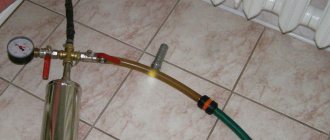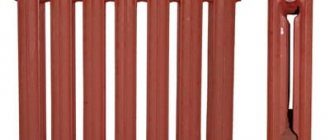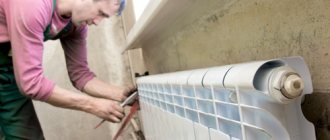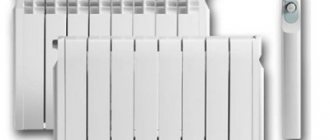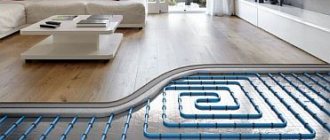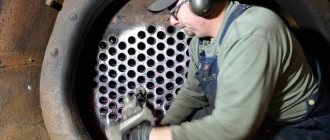Home/Leisure and recreation/3 simple solutions to increase the heat transfer of a battery. We increase thermal output during the heating season
The long-awaited heating season has begun, the apartments have become warmer, but the temperature does not justify the high price of heating. To retain maximum heat, it is important to take care of the thermal insulation of windows and the front door, and the next step is to take care of the radiators.
There are two large-scale measures that will improve the situation.
- Over time, the pipes of the heating system become clogged with layers of scale and rust, therefore, their internal volume decreases. Less water means less heat. To flush the pipes, you need to agree with the other residents and call a mechanic who will have access to the top floor and the basement.
- Old cast iron radiators are not as efficient as their bimetallic successors made of steel on the inside and aluminum on the outside. Simple logic dictates that if you install a battery from a larger number of sections, then its heat transfer will be proportionally greater.
What if there is no mutual understanding with the neighbors, but the heating has already been provided, so it will not be possible to replace the radiators this season? You can significantly increase the heat transfer of batteries in 4 simple ways.
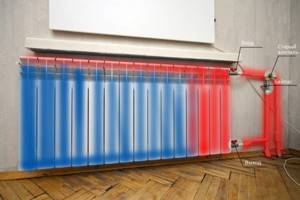
Experimental data.
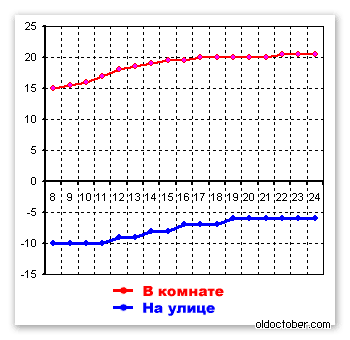
First day of the experiment.
All graphs show temperature changes from 8:00 am to 12:00 pm.
The coolant temperature is 42ºС.
The graph shows that the system worked more efficiently while the temperature difference between the air and the battery was large. When the difference decreased, the system stabilized.
The air temperature in the center of the room at a height of 65 cm from the floor rose from 15ºС to 20ºС in 9 hours.
Subsequently, the temperature rose another 0.5ºС.
The fan power consumption was 35.2 Watts.
When, during the experiment, I left my room into the corridor, I immediately felt the temperature difference, because by that time I had already taken off my warm clothes.
I went to the barn and brought out another fan. This fan was not equipped with a power switch, so I connected it through a homemade triac regulator, the design of which is described in detail here.
Well, life has become better, life has become more fun!
Second day of the experiment.
In the morning I again measured the coolant temperature, as well as the air temperature in the room. All values remained unchanged, including the outside temperature.
No changes in temperature were noticed during the day.
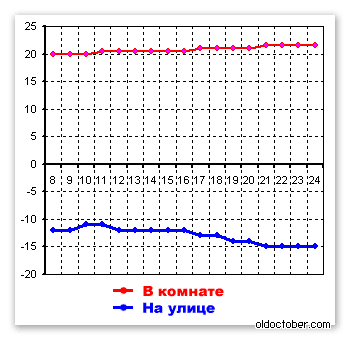
Third day of the experiment.
The coolant temperature increased by one degree and amounted to 43ºС.
The temperature outside dropped and reached -15ºС.
At the same time, the temperature in the room increased by another 0.5ºС and reached 21.5ºС.

Fourth day of the experiment.
The coolant temperature is still 43ºС.
The temperature outside in the morning is -15ºС.
The temperature in the room in the morning was 21.5ºС.
Since no significant changes in temperature were noted over the past 24 hours, I decided to increase the air flow and installed a second fan at 10.00.
After 10-15 minutes, the air temperature immediately increased by one degree, and then by another half a degree and reached 23ºС.
Let's go for a walk, I thought, and at 19.00 I turned on both fans at full power. The temperature increased by another degree in two hours and reached 24ºС.
Heat transfer of aluminum radiators: declared and real
Many years of experience in using aluminum batteries have shown that the parameters stated in product data sheets do not match the real numbers. This does not mean that manufacturers are lying, they just do not mention that these indicators are valid under ideal operating conditions, which, as a rule, does not happen in life.
For example, the heat transfer of aluminum radiators, which is indicated in the documents, may correspond to the truth if there is a difference of 70 degrees between the temperature of the air and the coolant. That is, the formula by which these parameters are calculated is as follows:
(treturn + tsupply): 2 – tair = 70 degrees
If the data sheet indicates the power of an aluminum radiator of 200 W at a temperature difference of 70 °C, then at room temperature +22 °C the calculations will be as follows:
(treturn +tfeed) = (22 + 70)x2 = +184 degrees.
Since according to GOST the difference in temperature in the supply and return should not exceed 20 degrees, their value can be calculated as follows:
The coolant temperature in the supply pipe is 184:2 +10 = 102 degrees.
In the return pipe it will correspond to 184:2 – 10 = 82 °C.
Based on these calculations, the aluminum radiator section will produce 200 W of heat, and the air in the room will warm up to +22 only if the coolant temperature is 102 degrees. This is unrealistic, since the maximum heating that modern boilers provide is 80-90 degrees, which means that the power of 200 W indicated in the data sheet does not correspond to the truth.
To figure out what the real thermal power of aluminum heating radiators is, there is a table with reduction factors. It is enough to multiply the parameters specified in the documents by the corresponding coefficients, and the real power of the heater will be obtained.
Ways to increase battery heat transfer
There are quite a lot of such methods, using several of them you can significantly increase the heat transfer of batteries.
Natural convention. This is the simplest way to increase heat transfer, based on an elementary natural law. The heated air rises to the top of the room, and after cooling it falls back down. To
The natural convention worked at full capacity; the batteries are best installed under the window. This will allow the cold air coming from the window to immediately heat up and rise to the top, rather than passing into the room unheated.

Freeing up space around the battery. This method will help the cold air heat up faster, since nothing will interfere with it. Placed furniture, thick textiles and various decorative decorations on the radiator significantly worsen and slow down the heating of the air.
If the batteries are open, the air circulation will not be disrupted and it will heat up quickly enough. Therefore, it is best to leave the space in front of the battery free.
Reflective screen. This screen is needed so that the battery does not heat the cold wall behind it, but directs all its heat into the room. The reflective screen helps with this; it allows you to direct the heat emanating from the battery in the right direction. Making such a screen is quite simple.
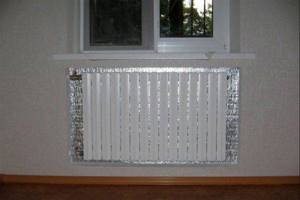
Can take either foil or any other material with a foil surface and attach it to the battery. The main thing to remember is that there must be a space of at least two centimeters between the material and the battery. This is necessary so that the air can circulate normally.
Electric fan. Installing such a device will improve air circulation, thereby speeding up the process of heating the air. This method is very effective and makes it possible to increase the temperature in the room by several degrees in a short time.
The main thing to remember is that the electrical appliance itself can overheat, so you need to turn it on only under supervision and not for a long time.
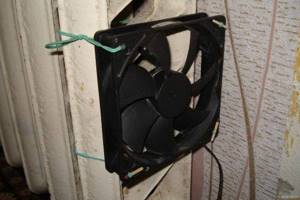
To ensure that the heat transfer of the battery does not deteriorate, it is necessary to regularly carry out wet cleaning. Dust significantly impairs the heat transfer of heating devices and pollutes indoor air.
Also, before the start of the heating season, you need to bleed the air from the batteries, as it greatly impairs the heating ability. This procedure should be carried out only after water has been released through the pipes. This reading of the battery will improve its heat transfer.

Such methods are quite effective; thanks to their use, the heat transfer of batteries can be significantly improved and the temperature in the room can be increased by several degrees. If these methods do not help in any way, then most likely you will still have to change the batteries to new and more powerful ones.
But the replacement cannot be carried out without the help of specialists, since this process requires certain knowledge and skills.
It also entails a considerable amount of material costs, so it is better not to replace and install new batteries yourself; it is better to turn to knowledgeable and experienced professionals.
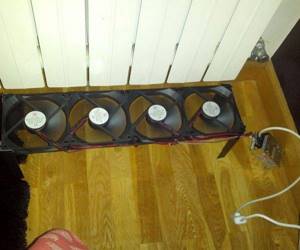
Provide air circulation
A radiator covered by a curtain, desk or other furniture first heats the nearest object, and only the remaining heat is distributed throughout the room. If the radiator is recessed into a niche under the window and the window sill covers it on top, heat transfer will be minimal.
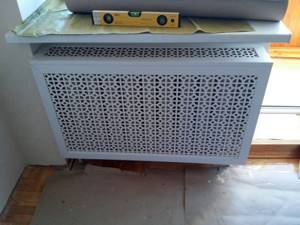
How to direct warm air to heat a room:
- remove furniture from the radiator, hang a short curtain (just below the window sill);
- install a fan at low power or a computer cooler so that it directs cold air to the radiator and pushes warm air into the room;
- make slits in the window sill and cover them with foil screens-covers - this way the warm air will not linger in the niche under the window and will be directed into the main room.
So, increasing the heat transfer of batteries is not difficult - even wet cleaning and a sheet of cooking foil can improve the situation.

AllaAuthor of the article
Did you like the article?
Share with your friends:
Comments (26)
- *** dog March 25, 2021 at 01:14 pm
2. The best way is to assemble a sectional heating battery from several dozen good video cards. A crypto farm is the only heating battery that makes a profit. Of course, in the future the profit will decrease, but after the video card pays off, even if all the funds for mining go to pay for electricity, heating will still be free.
Answer
- Alka February 05, 2021 at 22:02
Don’t bother with the nonsense with reflectors, but simply “attach” one at a time, two fans from the computer to the sides of the radiators to the wall, which will drive heat around the apartment with their air flow and you don’t have to bother with this topic anymore. Just make a switch, or better yet, an additional voltage regulator so that the “spinner” spins faster or slower and all your problems with heat will be solved, provided, however, that the batteries themselves actually heat up and do not create the illusion of heating.
Answer
- Evgeniy December 19, 2021 at 09:05 pm
Gentlemen! Before writing comments that betray your ignorance of the elementary laws of physics, spend at least 5 minutes on Wikipedia...
Answer
- zaschita96 December 13, 2021 at 01:27 pm
It all depends on the design of the house, in Khrushchev and panel houses the coolant is supplied differently, it is optimal to buy a cheap Chinese device and walk around the apartment, see where the heat is leaking, try to eliminate it, turn on the fan in economy mode to ensure air circulation, it is better with a timer so that it works at a time convenient for you and did not interfere with noise, as for the thermal insulation, it makes sense, it was used when insulating the loggia, on a six-meter loggia with the windows removed, there was a difference of about three to four degrees between the loggia and the room, until I installed an electric heated floor. with a temperature sensor, I live in the Urals, 40 degrees below zero, it’s comfortable, I have flowers, and other indoor plants on the loggia are fine, that’s the experience for 8 years.
Answer
- VITEK December 12, 2021 at 05:45 pm
Theorists! Water heats, not iron! 4 sections can fry better than 20.
Answer
- Dmitry December 31, 2021 at 8:24 am
If you place a reflective screen behind the radiator, the dew point moves into the room, and this causes condensation and mold.
Answer
- Valishevsky December 09, 2021 at 23:23
A reflective screen attached to the wall behind the radiator will help direct all the heat into the room. The most affordable option is made from foil-isolon - a foamed synthetic material (polyethylene) covered with foil on one side, writes the author of the article. A few years ago I took this advice. Two weeks later I removed the reflective screen. Behind it, on the side of the wall, mold appeared on the wallpaper. The wall is cold, there is no ventilation - damp and mold. In the comments, someone advised increasing the number of sections in the heating radiator. Ineffective. Water circulates through the first three to four sections. That's why they are always hotter than the others. My advice (prohibited) is to remove the half-inch jumper in front of the radiator, and if there are a large number of sections, make a diagonal battery connection. In the second option, water will circulate throughout all sections. Why is it prohibited - you will take heat away from your neighbors.
Answer
- TANYA December 08, 2021 at 20:58
To increase heat transfer, you simply need (by any means) to increase the heat transfer area of the heating element. Although the reflective effect of the screen is also a way.
Answer
- Sergey December 07, 2021 at 13:50
What is the reflector behind the battery for then? There is no need to paint the battery dark; it absorbs heat rather than reflecting it. I should have studied physics at school. Look at yourself in the mirror, what do you see? Then paint the mirror with dark paint, what do you see in the mirror?
Answer
- Evgeniy December 19, 2021 at 21:00
It really wouldn't hurt you to learn some physics))) A black body emits with the same intensity as it absorbs!
Answer
*** dog March 25, 2021 at 01:04 pm
Even I know that painting the body black only affects the emission/absorption of visible waves. If you need to heat water with a solar battery, it makes sense to paint it black. But the battery does not emit visible light. She studies thermal infrared. And in order for it to emit/absorb heat, it must not have a visible black color, but be a “black body” in the infrared range that is invisible to us. In general, you need to learn physics.
Answer
- Danil December 06, 2021 at 15:09
All this is nonsense, my system is filled with water charged by A. Chumak thirty years ago, so the batteries get very hot even when the boiler is turned off.
Answer
- Ivan. 10 Dec 2021 at 11:01
Goat
Answer
- Alexander Yakovlevich December 02, 2021 at 20:31
I agree with the first advice, and the rest are insignificant. If you need heat, which is not enough, add more radiators, thereby increasing the heat supply area. That's all.
Answer
- goga Dec 13, 2021 at 4:55 am
If the water temperature is 35 degrees, put 40 sections and it will be hot?
Answer
- Alexander December 01, 2021 at 07:26 pm
And also install a potbelly stove and heat it with anthracite.
Answer
- Law of Conservation of Energy November 30, 2021 at 04:18 pm
Along the way, a friend was having a hard time with physics at school.
Answer
- Alexander November 28, 2021 at 5:36 am
BATTERIES... You can immediately see a professional!!!
Answer
- Evgen November 25, 2021 at 06:40 pm
What nonsense! Where did the author of the article get these tips from? Did your neighbor's grandmother give you a hint? 1: How can a radiator casing increase heat transfer? Be it a radiator, or let us consider it a convector (although the author does not know this word). If we have a radiator, then even a sheet of newspaper will disturb the thermal radiation. If we have a convector, then the casing will spoil the convection, that is, something that the author is not aware of. Our white heating appliances are almost entirely convectors. Radiation is a few percent. Therefore, it makes no sense to paint them dark. I advise the author to think about his two tips: wipe off dust for better heat removal and install a casing for better heat transfer. Doesn't it contradict anything? I’m generally silent about the holes in the window sill. Nightmare.
Answer
- Igor November 29, 2021 at 04:57 pm
I was also surprised by the advice to paint the batteries a dark color, how this can affect heat transfer, interesting?
Answer
Alexander November 29, 2021 at 10:08 pm
The emissivity is higher. Heat is transferred not only by convection, but also by radiation. Therefore, the screen behind the radiator can add heat to the apartment. You can get the most out of the battery by blowing it with a fan. But there are disadvantages, there is a lot of dust and if everyone does this, then the one who lives closer to the boiler room will win, the rest will freeze.
Answer
- Serge December 09, 2021 at 03:24 pm
The shroud on the radiator makes it a convector, although not an efficient one. Slots in the window sill improve circulation around the room and the cold air from the window is immediately warmed up, but there is a drawback - we heat up the cold glass in vain. The batteries should not be painted then, but stripped down to cast iron. In general, the advice has not been finalized, the topic has not been addressed!)))
Answer
- Ivan Anatolyevich November 25, 2021 at 1:14 pm
Nonsense. Apparently the author of the article is completely far from practical physics and plumbing work. Never do this, but rather ask for help by calling +79257411008
Answer
- Is the author drunk? 25 Nov 2021 at 18:48
The author writes: cover the radiator with a metal casing. The radiator will heat the casing, and the casing WILL HEAT THE room MORE EFFECTIVELY. Is it okay that this is how a thermos works?! Is the author drunk or stupid?
Answer
Serge December 09, 2021 at 03:26 pm
The main thing in a thermos is the VACUUM between the walls!!!
Answer
- Victor December 10, 2021 at 01:57 pm
paint the ceiling, walls and floor in a dark color and hang garlic from all evil spirits and there is no need for heating, the holy spirit will warm you!
Answer
What is efficiency and how to calculate it
The heat output of heating devices, which include batteries or radiators, consists of a quantitative indicator of the heat that is transferred by the battery over a certain period of time and is measured in Watts. The process of heat transfer from batteries occurs as a result of processes known as convection, radiation and heat exchange. Any radiator uses these three types of heat transfer. The percentage of these types of heat transfer may vary among different types of batteries.
What will be the efficiency of heaters, in the vast majority of cases depends on the material from which they are made. Let's look at the advantages and disadvantages of radiators made from different types of materials.
- Cast iron has relatively low thermal conductivity, so batteries made from this material are not the best option. In addition, the small surface of these heating devices significantly reduces heat transfer and occurs due to radiation. Under normal apartment conditions, the power of a cast iron battery is no more than 60 W.
(See also: Which is the best heating radiator to choose)
Steel is slightly higher than cast iron. More active heat transfer occurs due to the presence of additional ribs, which increase the area of heat radiation. Heat transfer occurs as a result of convection, the power is approximately 100 W.
Aluminum has the highest thermal conductivity of all previous options, their power is about 200 W.

In addition, for the most efficient heating, you need to consider how much power you may need. When calculating the power of heating devices required for a room, the number of walls facing the street and windows is used. For every 10 m2 of floor with 1 external wall and window, about 1 kW of thermal power of the battery is required. If there are 2 external walls, then the required power is already 1.3 kW. (See also: Water-heated stoves)
The bottom connection is used if the heat-conducting pipes are hidden under the floor screed and does not exclude heat loss of up to 10% of the original value. A single-pipe connection is considered the least effective, since the loss of power of the heating device with this method can reach 45%.
Why does the battery's heat dissipation decrease over time?
The reasons for the decrease in heat transfer are often due to the design features of heating radiators. This parameter depends on:
- the type of material from which the radiator is made;
- number of sections in the battery;
- type of connection between the battery and the heating pipe;
- fluid (coolant) circulation speed in the battery;
- coolant heating level.
This means that a decrease in heat transfer is often explained by a decrease in coolant temperature or improper installation of the battery.
But if these factors are excluded, then this problem arises for the following reasons:
- clogging of radiators and heating pipes with rust, scale and other contaminants;
- formation of air jams in central heating communications;
- installing a decorative box on the battery;
- excessive contamination of the radiator;
- many layers of paint were applied over the heating device.
With the exception of the first two reasons, the impact of these factors leads to a slight decrease in heat transfer.
Frequent reasons for a decrease in heat transfer from a heating battery
Most often, the reason for the decrease in heat transfer from radiators is scale and rust that accumulates inside. If the radiator itself is flushed (which utilities should do annually), the heat transfer will increase significantly. The same applies to heating risers. However, it will not be possible to carry out such a procedure on your own due to the fact that when carrying out such work (even in summer), it is necessary to drain the water from the system. You can’t do this without the help of specialists. The same applies to replacing radiators from cast iron to bimetallic ones - they have greater heat transfer. Therefore, we will not dwell on such complex and time-consuming options. It’s better to consider simpler methods that any home craftsman can do, even without experience in this field.
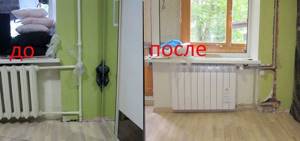
The heat output of bimetallic radiators is higher than that of cast iron
We use a reflective screen: the use of foamed polyethylene
Using a reflective screen is a fairly popular method of increasing heat transfer. Foamed polyethylene with a foil coating on one side is perfect for these purposes. Such a screen (it should be larger than the radiator itself) is placed behind the radiator with foil in the direction of the room and fixed to the wall with double-sided tape or liquid nails. Foamed polyethylene provides additional insulation, and the foil reflects the heat that warmed the wall before installing the screen, directing it into the room.
Important information! It is best when such moments are thought through at the stage of installing heating radiators. In this case, a steel ribbed shield can be attached to the radiator, which will accumulate heat and then direct it into the room. Such panels are convenient if heating outages occur frequently.
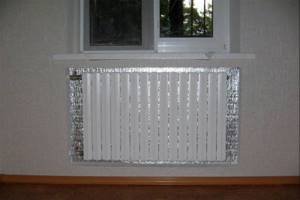
This is what a foiled polyethylene foam screen looks like
Also, basalt slabs with aluminum coating have worked well as a screen.
Increasing heat transfer with additional accessories and painting
To increase the air temperature in the room, special aluminum casings are used, which are placed on the radiator. With their help, the area of the heating battery increases and, as a result, their heat transfer. The cost of such casings is low, but the effect is quite significant.
The color the radiators are painted is also of great importance. It is better to choose darker shades for these purposes. For example, a radiator painted brown has 20-25% more heat transfer than white ones.

This casing improves appearance and increases heat transfer
Improving convection by increasing air circulation
Everyone knows that improving air circulation helps the room warm up faster. For these purposes, you can use a fan, which is installed in such a way as to achieve maximum flow of warm air towards the room.
Helpful information! If you have computer coolers at home that are not in use, you can install them under the radiator, directing the air flow upward. This will maximize convection, causing the room to become significantly warmer.
You can increase convection (if the radiator is recessed under the window sill) by cutting holes in the window sill and covering them with screens or decorative covers. Thus, warm air will not linger in the niche, which will improve circulation.
It's impossible to win this country! Self-installation of fans to improve convection:
Paint the battery dark
By repainting the battery dark brown, bronze or black, you can increase its heat transfer by 20-25%. Many manufacturers have enamels with high thermal conductivity.

Before painting, it is worth removing the previous layers of coating if possible - they act as thermal insulation and do not allow the battery to heat up at full power. If the radiator was painted with a new layer with each repair, it is not surprising that over the years it heats less and less.
Do not neglect wet cleaning, since a dense layer of dust between the radiator fins also blocks heat.
Prologue.
This year we are experiencing unprecedented frosts. In some areas of the republic, the air temperature dropped to -24ºС, which is an anomalous phenomenon for warm Moldova. I don’t have a thermometer hanging in my room, but I felt that my hand lying on the table began to freeze, and I had to put a piece of foam rubber under it.
We, in general, like the Amundsens, are already accustomed to the coolness, but yesterday the chairman of our condominium, while collecting signatures for an appeal to the heat supplier, asked what the air temperature was in our apartment. It is unlikely that the heat supplier will increase the temperature of the coolant, but perhaps the chairman wants to demand a penalty under the pretext of providing poor-quality services.
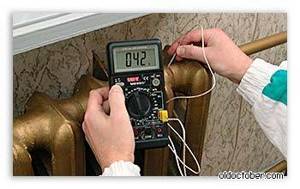
Be that as it may, this event first prompted me to measure the air temperature in the apartment, and then to conduct this experiment.
Of course, to say that this experiment was unclean is to say nothing. There are too many variables that could affect the accuracy of the result, from the direction of the wind overboard to the activity of the computer running in the room being tested.
But the most important parameter, which at another time would not have allowed this experiment to be carried out at all, is the stability of the coolant temperature.
The fact is that in warmer periods of time, the temperature of the coolant is actively regulated during the day to save energy consumption. When the temperature outside is abnormal, all the valves open wide.
Changing the radiator connection method
Are you familiar with the situation when half the battery is hot and half is cold? Most often, the connection method is to blame in this case. Take a look at how the device works with a one-way radiator connection with coolant supply from above.

Notice how much worse the distant sections perform
Now let's take a look at the one-way connection diagram with coolant supply from below.

We see the same effect
But here is a two-way connection with supply from above and below.

We see the same effect

We see the same effect
If you find yourself with one of the schemes presented above, then you are out of luck. The most rational from the point of view of operational efficiency is a diagonal connection with a feed from above.
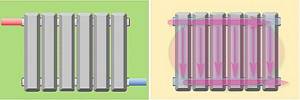
The entire heat exchange area of the radiator is heated evenly, the radiator operates at full power
And what to do in the case when you don’t want to change the pipe layout or it’s impossible? In this case, we can advise purchasing radiators that have some cleverness in their design. This is a special partition between the first and second sections, changing the direction of movement of the coolant.
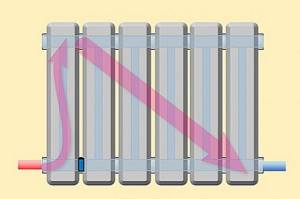
A special plug turns the bottom two-way connection into the diagonal connection we need with the top connection
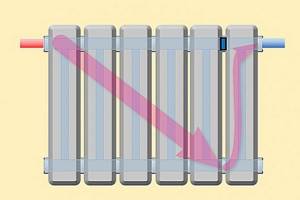
And this option is suitable for the top two-way connection
In the case of a one-way connection, special flow extenders have shown their effectiveness.

Operating principle of the flow extender
There are devices for optimizing one-way bottom connections, but we think the general principle has now become clear to you.
Conclusion: 100% effective.
Ways to increase heat transfer
At the moment, there are several ways to increase the heat output from a heating system that has already been created and was in operation, but did not live up to your hopes:
- Installation of convectors. This design is made of a pipe with metal plates strung on it, either made by hand or factory-made.
- Painting the main pipeline black or another dark color. This method, despite its simplicity, is quite effective. In addition, the color can quite organically fit into the modern design of premises, unlike the recent past, when this was considered a necessary measure.
Note! Paint is only an additional method, which is relevant in rare cases, since the efficiency is too low to “admire” the black stripes.
- Installation of registers in the heating system. The register consists of several large diameter pipes connected to each other and with welded ends. Such designs include heated towel rails in the form of a coil with several loops.
- Rearrangement of radiators with the addition of sections. This option is the most expensive, but is also higher in efficiency than the others.

If you decide to add radiators, be sure to place them under the windows or next to the front door (as in the photo)
We recommend! Don't forget that installing additional insulating materials also allows you to increase heat transfer, reducing the loss of generated heat. However, it is only possible when constructing a residential building from the foundation, or when dismantling the facade.
Reasons for poor heat transfer
The efficiency of the heating system in an apartment is influenced by various factors. The efficiency of batteries depends most on the following conditions:
- material for the manufacture of pipes, radiators;
- the size of each radiator in the room;
- hot water circulation speed within the system;
- liquid heating temperature.
If the above indicators are optimal, but heat dissipation is still low, the cause may be contamination of the battery from the inside. This occurs due to the accumulation of rust, dirt, scale, plaque, and solder. In old houses, professional cleaning of pipes, radiators and risers often seriously increases their heat transfer.

Flushing cast iron radiators
In addition, covering the batteries with decorative boxes or painting too frequently, as a result of which the metal remains covered with a very thick layer of paintwork, can reduce the efficiency of the system. Risk factors include air pockets inside the pipes, as well as external contamination of the radiators.
Registers
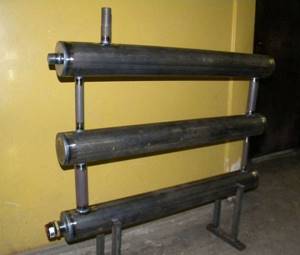
This was a very simple and cheap solution in situations where large areas needed to be heated. Although if we talk about the heat transfer of a pipe in such a register in comparison with an aluminum radiator, the difference in efficiency is staggering. Due to the larger area of the radiator heat exchanger and the thermal conductivity of aluminum, modern equipment is undoubtedly preferable. And externally the registers looked quite rough.
However, for their time registers were acceptable due to their cheapness and simplicity. It can be noted that the welds on them were very strong, and pipe clogging did not interfere with their functioning.
How to connect radiators to a single-pipe heating system
Widespread due to its low cost and ease of installation. In most apartment buildings, the piping is done in this particular way. In private buildings it is less common. Radiators are included in the wiring in series. The coolant makes a circle from the boiler, visiting each battery in turn. From the extreme section of the chain, the liquid returns to the return inlet.
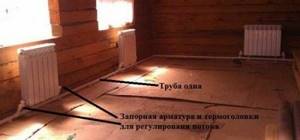
Such a system has a couple of disadvantages:
- Inability to adjust individual radiators. Installation of a controller is possible, but only the complete circuit can be controlled.
- Serial connection leads to deterioration of heating in distant sections of the piping, since the working fluid loses heat along the way.
Underfloor heating systems
If we are talking about a water heated floor, unlike its electric counterpart, it uses metal pipes as a heating circuit, although they have recently begun to be used less and less.
The main reason for the decline in demand for water-heated floors is the gradual wear of steel pipes and a decrease in the clearance in them. In addition, the installation method also matters - not everyone can make welds, and a threaded connection threatens to leak coolant after some time. Naturally, no one will like the result of water leakage from the system in a floor with a screed - the ceiling of the lower floor or basement will be flooded, and the ceiling will gradually become unusable.
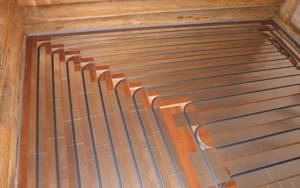
For these reasons, steel pipes in warm water floors were first replaced by metal-plastic coils, the fittings of which were attached outside the screed, and now reinforced polypropylene is preferred.
This material has a slight thermal expansion, and with proper installation and operation, they can last for decades. Alternatively, other polymer materials are used.
Please note that gaps for thermal expansion of reinforced polypropylene still need to be left, although it is small
Installation methods
The heat transfer rate of heating radiators depends not only on the material used for their manufacture. It is equally important to correctly connect devices to the heating system. There are several ways to do this :
- Diagonal. The coolant supply pipe is connected from the top left, and the diagonal outlet is connected from the bottom right. This is the most efficient way to connect radiators, as the device warms up completely.
- Side. Both pipes are connected on one side. Not the most effective way - if the battery contains many sections, they will not be able to warm up completely.
- Bottom connection. The pipes are connected from both sides from below.
- Top connection. The coolant supply pipe is connected from the top left, and the outlet pipe is connected from the bottom right.
Small details.
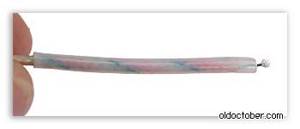
To quickly and accurately measure the temperature of a steam heating battery, it is enough to apply a small amount of “KPT-8” thermal conductive paste to the sensor ball of a digital thermometer. During the measurement, the contact area should be covered with several layers of fabric or a layer of foam rubber.
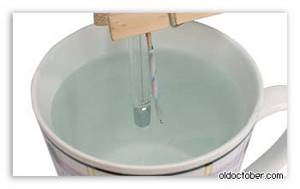
The above experiment made me question the accuracy of my digital thermometer. To make sure his readings were correct, I compared them with the readings of a mercury thermometer. To do this, I immersed both thermometers in hot water to the same depth and monitored the readings as the water cooled.

Prolonged operation of fans immediately revealed the weak point of modern devices.
If the 1973 Penguin fan has a front sliding bearing equipped with an oil seal (the arrow marks the hole for filling the oil seal), which has allowed it to work for almost 40 years, then in a modern fan there is no trace of such an oil seal.
In addition, the Penguin has a spring that prevents longitudinal vibrations of the shaft. The new fan, after two days of operation, began to rattle, because due to the longitudinal runout of the shaft caused by the eccentricity of the propeller, one of the fluoroplastic gaskets quickly wore out.
To eliminate the longitudinal play, several ordinary and two thin-walled washers were needed, as well as a gasket cut from foam rubber.
First I disassembled the stator.
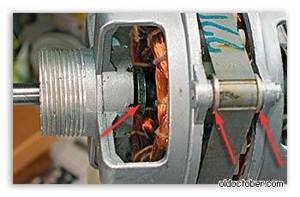
Then I put thin-walled washers and a gasket on the motor shaft, and used the remaining washers to increase the gap between the bearings.

To ensure any long-term operation of the fan, I cut out an oil seal from felt, and a seal plug from some nylon cover and pressed it all into the recess around the shaft. Naturally, I didn’t skimp on the oil either.
I started thinking about buying two dozen 120mm computer fans. I think if you install them directly between the battery sections, it should reduce noise and increase heat transfer efficiency.
Extension of radiators
To increase the heating radiator, you must wait until the end of the heating season. Before proceeding with the procedure, you need to remove the battery and then disassemble it. But before these actions it is necessary to turn off the water.
Old radiators often develop dirt and rust between sections. Naturally they will need to be removed. This can be done using a wire brush or sandpaper. After this, you can put on the gasket and connect the radiator sections.
Before extending the radiator, it is necessary to place the heating battery on the floor along with the new sections. Next we proceed to attach the nipple. But be sure to monitor the position of the thread. It is recommended to start turning the nipple on the left. In this case, you need to bait it 1 turn to the left of the battery. Then we carry out the same actions with the right side of the heating radiator.
It is necessary to control the position of the intersection gasket. It should be located strictly in the middle of the nipple. The battery section should be firmly attached to the nipple. After this, you can insert the radiator key into the radiator, and screw the nipple into the battery section with an adjustable wrench.
For high-quality extension of heating radiators, it is necessary to tighten the nipple 3-4 turns. Then you can go to the other side of the radiator and also tighten the nipple 3-4 turns. This procedure must be repeated until the sections fit tightly to each other.
After the sections have been built up, it is necessary to install side plugs, which are available for cast iron radiators. You also need to install special gaskets. They are made from paronite. You should check the surface where the gasket will be laid. If there is rust or other defects on it, they must be removed with sandpaper. After this, you can install the plugs. They must be tightened tightly using a pipe wrench.
By all parameters, the system is considered ineffective, since such a system contains a large volume of coolant that must be heated and maintained at temperature. But then you invited a competent plumber and he made a closed system from your gravity system with the possibility of forced circulation. And even in this case, the system becomes 20-30 percent more efficient.
So, in order for the home heating system to be effective, it is necessary that the amount of coolant in it be as small as possible and that the heating system heats your home on your terms.
And if you look at the house heating systems presented today, you can identify several systems that are suitable for efficient home heating.
Radiator system
Since most of the radiators are installed today, we’ll start with them. For example, you have a radiator heating system with cast iron radiators. Ineffective. What can be done to make the system more efficient? Of course, change the radiators. And the smaller the volume of coolant in the radiator, the better.
The easiest way is to replace cast iron radiators with aluminum ones. The most ideal thing is to change to copper-aluminum radiators and so on. You can also change the boiler to a more modern and economical one. You will end up heating your home more efficiently.
In addition to replacing the boiler, you can add another energy source or even a heat pump.
Warm floor
But if we talk about how effective home heating is today, then the underfloor heating system or underfloor heating system certainly comes to the fore.
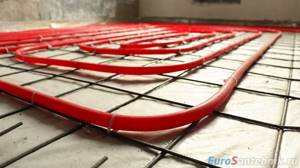
Efficiency is achieved due to the fact that the system requires a lower coolant temperature to operate than, for example, a radiator heating system.
Underfloor heating systems are very flexible in design and installation. Heated floor systems do not take up space in the room. Heated floor systems are suitable for any interior and solve a lot of other problems in addition to heating. I will tell you about these tasks in the following articles.
If everything is done correctly, underfloor heating systems save up to 75 percent of heating costs. This is what I mean by efficient home heating.
Thank you for reading this article. Share this article in the comments, like and write comments on the topic, what needs to be done to increase the efficiency of your heating system?
Methods for increasing heat transfer
The round shape does not at all help to increase the heat transfer of metal pipes. An even lower volume-to-surface ratio can only be found in a sphere.
Consequently, the problem of how to increase the heat transfer of a pipe undoubtedly faced the developers of the first simple heating devices.
To increase the heat transfer coefficient of a steel pipe, the following methods were previously used:
- The surface of the pipe was coated with matte black paint to enhance the infrared radiation of the heating element. This made it possible to achieve a significant increase in room temperature. It is worth noting that modern chrome plating on heated towel rails is extremely ineffective for enhancing heat transfer - it is, rather, for beauty.
- Increasing the heat transfer of the pipe by welding additional ribs onto it, which made the area of the heating element, and therefore the heat transfer, significantly larger. The most advanced use of this method can be called a convector, that is, a section of bent pipe with welded transverse ribs. Although the pipe itself in this case gives off a minimum of heat.
Any of these methods can be used if the question is how to increase the heat transfer of a heating pipe with your own hands, because they are not at all complicated and are quite feasible at home.
Ball Valves
Valves are cheap, but at the same time ineffective control devices. Ball valves are often installed at the entrance to the radiator, with the help of which they regulate the flow of water.
But this equipment also has another functionality - shut-off valves. Valves are used to completely shut off the flow of coolant into the system. For example, in the event of a leak in a heating device, ball valves located at the inlet and outlet of the radiator allow repairs to be made without stopping the heat supply and draining the liquid.
Heating radiators in the apartment cannot be adjusted using ball valves. They have only two positions - completely closed and open. An intermediate position only brings harm.
The fact is that inside such a faucet there is a ball with a hole, which in its normal position is not in danger, but in all other situations the solid particles present in the coolant grind it down and pieces break off from it. As a result, the tap will not be sealed and in the “closed” position, water will continue to flow into the battery, which can lead to big troubles if the device leaks.
If one of the property owners decides to control the radiators using ball valves, you must remember that they should be installed correctly.
This method is usually used in apartment buildings. If the wiring is single-pipe vertical, then the hot water pipe enters the room through the ceiling and a radiator is connected to it (read: “Correct adjustment of heating radiators in an apartment - comfort in the home and saving money”). The pipeline departs from the second entrance to the device and is directed through the floor to the room below.
In this case, it is necessary to install the taps correctly, since the installation of a bypass is mandatory. The bypass pipe is needed so that when the liquid flow to the radiator is closed, the coolant continues to circulate in the general house system.
In some situations, the tap is placed on the bypass to change the amount of water passing through it and thereby adjust the heat transfer of the battery. To ensure greater reliability of the heating system, at least three valves are installed: two will be shut-off valves on the radiator and function normally, and the third will become a regulating valve.
But here we must not forget what position the devices are in. Otherwise, you can completely block the riser and you will not be able to avoid the cold in the apartment, as well as unpleasant showdowns with neighbors and representatives of the management company.
Painting the radiator dark
Another opinion that wanders on the Internet is that painting the battery black or brown increases heat transfer by radiation. In most cases, such judgments are based on the physical concept of an “absolute black body,” which absorbs and emits the most. All this applies to the heating battery. Those painted with light paint emit less radiation than those painted with dark paint. Let's figure out how much.
A little physics. According to the Stefan-Boltzmann law, the radiation of an absolutely black body is proportional to the absolute temperature to the 4th power.
R(T) = σ × T4, where
σ = 5.67·10-8 W/(m2K4) - Stefan-Boltzmann constant.
Real bodies are classified as “gray”. For real “gray”, its emissivity ε must be taken into account. The battery itself absorbs IR radiation from the room, and the textbooks provide a corresponding formula, which includes the temperatures of both the battery and the room (in Kelvin to the 4th power). It is easy to show that if you heat a battery from 20°C to 40 degrees, its radiation will increase 81 times. The calculation (approximate, of course) shows the following. Let a battery with an area of 1 sq. m is painted with brown oil paint (for it ε ≈ 0.8). Let the water temperature in it be 70°C, and the room temperature - 20°C. Then the IR radiation power of such a battery will be 300 W. Not so little! A battery painted with matte black (not glossy!) paint will heat up even more. And if the paint is white, the radiation power will be lower. But aesthetic considerations usually take precedence, and batteries (open) are usually painted with light colors.
Black radiators can also be freely found on sale Comment Sergei Kharitonov Leading engineer for heating, ventilation and air conditioning LLC GC Spetsstroy Ask a question “Physics directly proves the effectiveness of painting a radiator in dark colors, but all this applies to ideal operating conditions. Let me remind you that in conventional water batteries convective heat transfer predominates and color does not affect it in any way. In addition, you need to be confident in the quality of the entire heating system. If 30°C comes into your radiator, then don’t paint, it won’t do any good. Well, don’t forget about the aesthetic component. Are you ready to contemplate black “coffins” every day for the sake of a few tens of extra watts?”
Conclusion: effective, but requires ideal operating conditions.
How to increase the efficiency of a heating battery?
Find out the cost of repairs
Repair work?
Why do clients choose us?
Heating and Repair
We have the best prices!
The heating circuit has an expansion tank, boiler manifolds, a connection system, batteries, thermostat pipes, fasteners, pressure-increasing pumps, and air vents. The cottage heating system includes important components. Any element has an undeniable role. Based on this, the matching of all parts of the system must be done correctly. On this resource tab we will try to determine the necessary system components for the apartment.
Heating battery efficiency
The boiler room smokes from the heat, but the house is still cold? What is the reason for this situation? Perhaps your cast iron batteries are simply not able to cope with the load, which especially increases during severe frosts? How to increase the efficiency of a heating battery? In this case, there is a way out - moving the heating radiators and expanding them. After all, it is not necessary to replace radiators; you can simply move them to more optimal conditions and increase the missing number of sections.

A large battery can easily heat a spacious room
Before you expand the heating battery, if it is cast iron, you should remember that this can only be done after the end of the heating season! After all, in order to add new sections of such batteries, it will be necessary to completely disassemble the batteries. And if this is carried out in winter, then the entire system will need to be shut down. And if you live in an apartment building, it is unlikely that any of your neighbors will agree to spend several hours without heat.
Therefore, such a process should be postponed until warmer times. How to build up a heating radiator made of cast iron? Let's look at the process in more detail. We will need the following tools:
- Radiator or adjustable wrenches;
- Nipples are clearly for cast iron radiators (the number depends on the sections);
- Special gaskets to install them between sections.
- Side plugs with gaskets.
So, before you add a cast iron radiator, you will need to remove and disassemble it. Don't forget to turn off the water first!
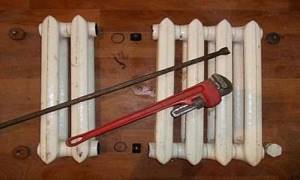
Tools for adding new cast iron battery sections
If the batteries are not new, there may be a build-up of rust and dirt between the sections. To install the gasket and connect the battery sections, such build-up will need to be removed. This is done either with sandpaper or a wire brush.
Before expanding the heating radiator, you need to lay out our battery on the floor and additional sections.
When you attach the nipple, pay attention to the position of the thread. We begin to twist the nipple on the left, first it is best to attach it approximately 1 turn to the left of the heating radiator. We do the same with the right side.
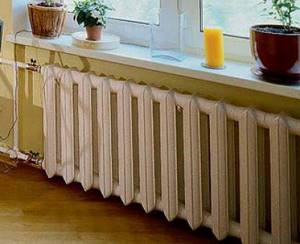
Extended cast iron heating radiator
It is imperative to ensure that the intersection gasket is placed only in the middle of the nipple. The radiator sections must fit snugly against the nipple. Now we insert the radiator wrench into the radiator, and use an adjustable wrench to screw the nipple into the radiator sections.
To make a high-quality expansion of heating radiators, you need to tighten the nipple three to four turns and move to the other side of the sections. We will tighten the sections one by one until they fit one another very tightly.
Now it's time to install special side plugs for cast iron radiators. Do not also forget about gaskets made of a special material - paronite. If there is rust on the surface on which the gasket is supposed to be installed, it must also be cleaned with sandpaper. And only now can you put the plug in. The plugs must be tightened tightly using a pipe wrench.
Thus, we looked at how to add cast iron heating radiators. If you have the desire and opportunity, you can install taps on them. However, it is worth noting that insufficient heat in rooms heated with cast iron batteries can arise not only due to the fact that the batteries do not pull the load. Very often, cast iron batteries are painted, adding a layer of new paint to their surface year after year. Of course, such a “fur coat” can lead to a reduction in the efficiency of heating radiators by a certain percentage.
If you decide to update the heating batteries, then in order not to deteriorate the efficiency of the heating batteries and their other characteristics, you simply need to remove the layer of paint that was there before.

Painting a heating radiator
In addition, for painting it is worth using not ordinary enamel, but paint that is not exposed to high temperatures. Regular enamel can turn yellow over time if exposed to constant heat.
But if it’s a matter of load, then we already know how to increase the efficiency of the heating battery. In order not to carry out additional unnecessary work in the future, you should calculate everything well from the very beginning - not only when you already need to add sections of the heating radiator, but also when installing the heating system, when replacing old batteries with new ones.
Among other things, the question of how to improve the heat transfer of a heating radiator can be solved by selecting better materials. After all, the efficiency of the heating system largely depends on the characteristics of the materials.
Our video materials will help you on how to build up heating radiators. The most important thing is to be careful in your work, and then you will be able to make the heating system in your home more efficient.
Heating battery efficiency
In order for the heating system to work efficiently, it is necessary to correctly calculate the radiator power. And in order to increase the efficiency of heating batteries, you need to follow the instruction manual, which consists of only five points.
- Dust must not be allowed to accumulate on the heating device, as it interferes with heat transfer. Also keep the inside of the heater clean. If you do not follow this step, then after a while you will have to replace the old radiator with a new one.
- It is better to paint a heating device with dark-colored paint, because it is the dark color that not only absorbs heat well, but also emits it. For this, zinc-based white is used; enamel can also be used, but it is first dissolved in gasoline. After painting the heating battery this way, its efficiency will increase by 15%.
- Behind the heating device, foil is attached to the wall, and this directs the heat from the radiator into the room, and does not go outside or into the wall. You can also attach a heat-reflecting screen under the pipes, which is not only sold in the store, but is easy to make yourself. Take a sheet of metal (or foil) and attach it behind the battery.
- If you increase the surface area of the heating device, then the efficiency of the radiator will also increase, since there is a direct proportional relationship between them. You can also use special casings for this, which can be made of aluminum or iron. We must remember that aluminum heats up quickly and transfers all the heat into the room. In the event that the radiators work efficiently, but the housing and communal services turn off the heating, then it is better to purchase an iron casing that takes a long time to heat up and also takes a long time to cool down, so that until the heating is turned on again, you will have heat.
- If heating radiators heat up very much and during the season you have to open vents or windows, then in order to remove heat from the radiator, fans are directed onto it, which are positioned so that the air is directed towards the exit of the room. If there are several unnecessary coolers from the computer, they are mounted below the radiator. These devices will help air (from floor to ceiling) circulate faster.
How to install any radiators
The coolant in central heating has special impurities that negatively affect many radiator models. That's why they are not installed in apartments. In fact, to solve this problem, we need to make sure that instead of the thermal power plant coolant, we use our ordinary water.
For these purposes, you need to install a heat exchanger at the entrance of the central heating risers into the apartment.
A heat exchanger is a device that removes heat from one source and transfers it to another source. Simply put, this is our intermediary who will simply take heat from the thermal power plant and transfer it to our own heating system inside the apartment.
What are the benefits of a heat exchanger?
- Performs the function of a boiler by removing heat
- Allows you to create your own heating system inside the apartment with your own coolant and pressure.
- Allows you to implement any heating options
Using a heat exchanger also has its disadvantages:
- It gets clogged from time to time. Requires dismantling and washing
- In addition to the heat exchanger, it is necessary to install an expansion tank, pump and related fittings.
Having installed the heat exchanger, you can mount any radiator system: radiator, two-pipe and others. You can hide the pipes in a screed. You can use any pipe materials without worrying that they will become unusable. Any brand of radiator can be used.
Conclusion: how to make your apartment warmer
In fact, it is impossible to actually increase the amount of heat without changing the input parameters of the system (radiator material, its size, heating temperature). Using the above methods, there is a chance to use this heat more efficiently - completely, with maximum efficiency and optimal distribution in the apartment. For example, a screen will prevent thermal energy from being lost, and a fan will allow the warm air flow to spread more evenly.
If the apartment is cold, and this interferes with the normal life of the owners, more radical measures will have to be taken. These include:
- replacing old cast iron batteries with modern bimetallic radiators;
- “increasing” the number of sections on the battery;
- insulation of the wall behind the radiator and installation of a powerful steel screen.
When carrying out a major overhaul of the heating system, you need to remember: even the highest quality appliances need to be updated after 20–25 years, as their service life is coming to an end. It is worth choosing batteries from the most “advanced” materials of modern design - they are the most energy-intensive and will certainly help make the apartment warmer and more comfortable.
Estimated indicators
To calculate the power of heating equipment, as well as to find out the scale of heat loss during transportation of the coolant, it will be necessary to remove heat from the pipe at certain temperatures of the liquid inside it and the air outside. The thermal insulation layer serves as an additional parameter.
The formula for calculating the heat transfer of a steel pipe looks like this:
Q=K×F×dT, in which:
Q – the desired result of heat transfer from a steel pipe in kilocalories;
K – thermal conductivity coefficient. It depends on the pipe material, its cross-section, the number of heating circuits, as well as the temperature difference between the outside air and the coolant;
F is the total surface area of a pipe or several pipes in the device;
dT – temperature pressure, that is, ½ the total temperature of the liquid at the inlet and outlet of the pipe minus the air temperature in the room.
If the pipes are additionally wrapped in a layer of thermal insulation, then its efficiency in percentage terms (the amount of heat passed through it) is multiplied by the resulting heat transfer rate.
For example, let’s calculate the heat transfer of a register made of three pipes with a cross-section of 100 mm and a length of 1 m. The temperature in the room is 20 ℃, and the coolant, when passing through the pipe, cools from 81 to 79 ℃.
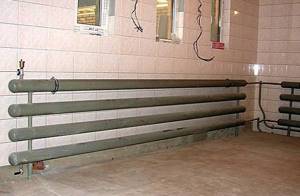
According to the formula S=2pirh we calculate the surface area of the cylinder:
S= 2×3.1415×0.05×1=0.31415 m2. If there are three pipes, then their total area will be 0.31415 × 3 = 0.94245 m2.
Indicator dT = (79+81):2-20 = 60.
The value of K for a register of three pipes with a temperature head of 60 and a cross-section of 1 meter is taken equal to 9. Therefore, Q = 9 × 1 × 60 = 540. That is, the heat transfer of the register will be equal to 540 kcal.
Thus, we examined the concepts of heat transfer, as well as ways to minimize the heat loss of a steel pipe for certain cases. There is nothing very complicated about this. The main thing is to approach the issue responsibly.
Reasons for reducing the efficiency of heating boilers
Even before increasing the efficiency of the heating battery, you need to decide on this parameter. In fact, it consists of several components - the efficiency of the boiler, radiators and pipelines. But besides this, you need to take into account the amount of heat loss of the building.
Therefore, you should first not think about how to increase the efficiency of the heating battery, but improve the thermal insulation of the house. Only by reducing losses through walls and windows can you begin to modernize your heating. It is mistakenly believed that the main indicator of the system is the efficiency of gas heating boilers or their solid fuel analogues. However, the actual beneficial effect of the system is determined by the following formula:
Q=Vinput/Vinput
Where Q is the efficiency indicator, Vinput is the amount of energy spent on heating the coolant, Vinput is the actual heat transfer to the air in the room.
When analyzing the operation of a boiler, especially a gas type, it is clear that it does not function all the time. It must maintain the heating level of the coolant at the set thermal mode. Other elements of the system - pipelines and radiators - are responsible for transmitting energy. It is they who first need to pay attention, since the efficiency of the heating system depends 80% on their proper functioning.
What needs to be done to ensure that this indicator is initially maximum:
- Select low temperature operating mode. With a minimal difference in water heating after the boiler and in the return pipe, energy costs will decrease;
- Use of electronic control systems - thermometers and programmers. They will allow you to automatically change the operation of the boiler when the temperature in the house and outside changes;
- Upgrade elements to achieve maximum heating efficiency in the house.
All these methods are interconnected with each other. Therefore, when organizing heating, you need to approach each stage professionally.
During the design of the system, it is necessary to calculate its main parameters - heat losses, the operation of each node and the optimal temperature regime. This can be done using online calculators (high error) or by ordering a service from specialized settlement bureaus (accurate data).
Summarize
There are many ways to increase the heat output of heating radiators. Today we looked at only the main ones. However, it should be remembered that it is always easier to think through everything in advance, at the installation stage, than to put in a lot of effort later, without the confidence that the result will be significant. Unfortunately, in Russia everything is done at random. The final advice from the Homius.ru editors would be this: think about the future and spare no expense during installation. The financial resources saved today can turn into costs tomorrow that will be many times greater than your savings.

The most optimal option is that all the heat rises, which creates normal heat exchange
We hope that the information presented in today’s article was interesting and useful to our dear reader. Despite the fact that we tried to present everything in sufficient detail, you may still have questions about the material. In this case, ask them in the discussions below - the Homius.ru editors will be happy to answer them as quickly as possible. If you know a way to improve the heat transfer of radiators that is not reflected in today’s article, please share it with other home craftsmen - this information will be very useful. And finally, we suggest watching a short but quite informative video on today’s topic.
How to increase the heat transfer of a central heating battery?
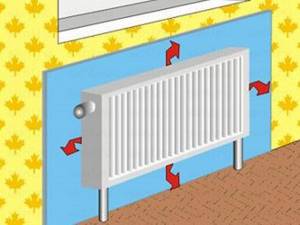
From the author: Hello, dear readers! The issue of energy efficiency has recently interested an increasing number of responsible homeowners.
Many of them want to make their home as comfortable and warm as possible and not waste money. Numerous articles on the Internet are devoted to the question of how to increase the heat transfer of heating batteries.
In this material we will analyze the most accessible methods that can increase the heat transfer of the central heating system in an apartment.
Experts say that the air temperature in the room does not always depend on the quality of the batteries. Before you start calculating the heat transfer of a radiator, we advise you to check the thermal insulation of windows and doors. If everything is normal with these positions, then you can begin to modernize the heating system.
